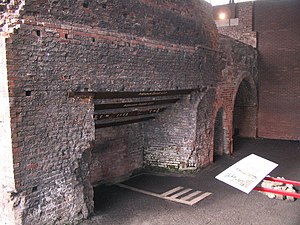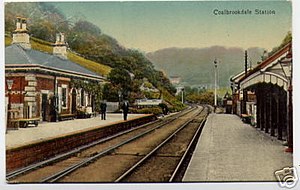Coalbrookdale
Contents
The Coalbrookdale Company
The Coalbrookdale Company was formed by Abraham Darby I in 1709 when he acquired the lease to the Coalbrookdale furnace. In 1768 his grandson Abraham Darby III began to produce the first cast-iron rails for railways, and in 1778 began casting parts for the world's first cast-iron bridge at Ironbridge which opened in 1780.[2]
In 1802 the Company made the high pressure boiler and engine for one of Richard Trevithick’s early locomotives, a predecessor of Catch Me Who Can.[2] It also built a number of its own standard gauge steam locomotives of which Number 5, built in 1865, is preserved as an exhibit in Enginuity, one of the Ironbridge Gorge Museums based at the Coalbrookdale site.[1]
The Coalbrookdale Company was responsible for the manufacture of the ironwork of Victoria Bridge which was built between 1859 and 1861. It had previously produced the ironwork for Brooksmouth Bridge, built in 1828, which can be seen from the SVR near Borle Viaduct. The 39ft diameter waterwheel wheel at Daniel's Mill was also cast by the Company circa 1855.
Railways associated with Coalbrookdale
The first plans for the Severn Valley Railway proposed that the north end of the line should proceed towards Coalbrookdale. However following public meetings in October 1852, a route towards Shrewsbury was ultimately built instead.[3]
See also
References
- ↑ 1.0 1.1 Ironbridge Gorge Museum Trust
- ↑ 2.0 2.1 Shropshire History
- ↑ Marshall (1989) pp. 21-22.

